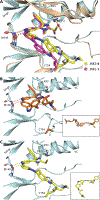Controlling the Covalent Reactivity of a Kinase Inhibitor with Light
- PMID: 34081840
- PMCID: PMC9940781
- DOI: 10.1002/anie.202103767
Controlling the Covalent Reactivity of a Kinase Inhibitor with Light
Abstract
Covalent kinase inhibitors account for some of the most successful drugs that have recently entered the clinic and many others are in preclinical development. A common strategy is to target cysteines in the vicinity of the ATP binding site using an acrylamide electrophile. To increase the tissue selectivity of kinase inhibitors, it could be advantageous to control the reactivity of these electrophiles with light. Here, we introduce covalent inhibitors of the kinase JNK3 that function as photoswitchable affinity labels (PALs). Our lead compounds contain a diazocine photoswitch, are poor non-covalent inhibitors in the dark, and become effective covalent inhibitors after irradiation with visible light. Our proposed mode of action is supported by X-ray structures that explain why these compounds are unreactive in the dark and undergo proximity-based covalent attachment following exposure to light.
Keywords: JNK3; covalent inhibitors; kinase inhibitors; photopharmacology; photoswitchable affinity labels; photoswitches.
© 2021 Wiley-VCH GmbH.
Figures




References
Publication types
MeSH terms
Substances
Grants and funding
LinkOut - more resources
Full Text Sources

